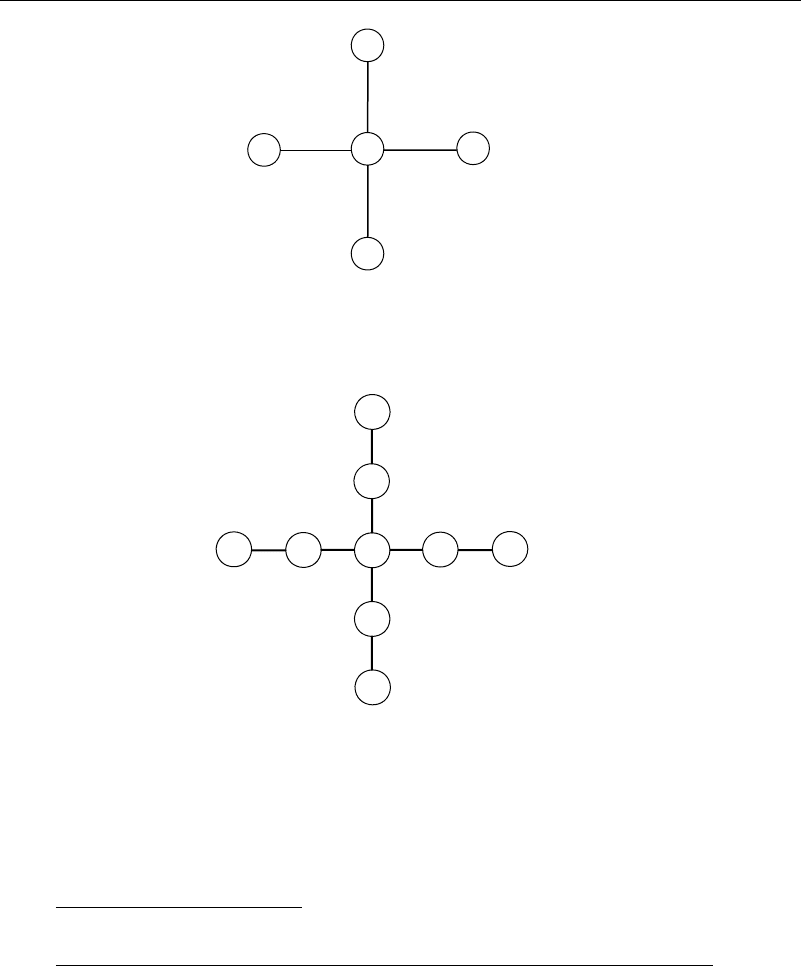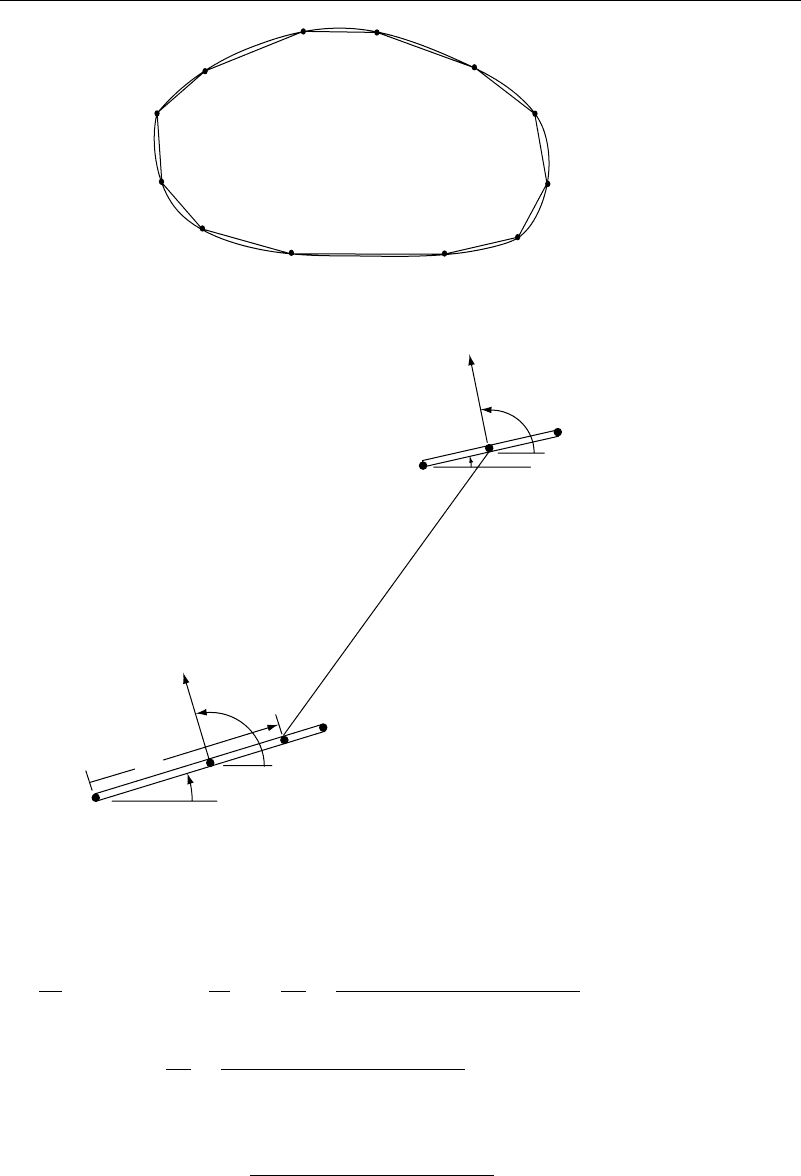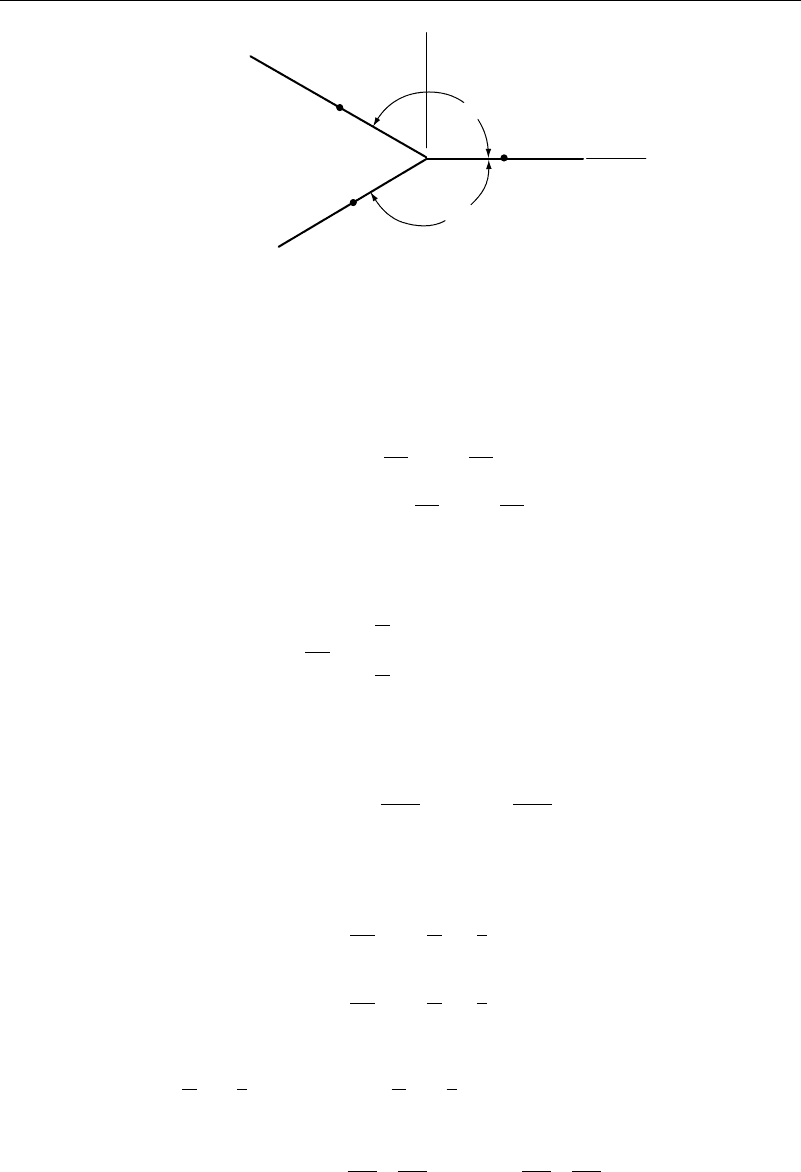Graebel W.P. Advanced Fluid Mechanics
Подождите немного. Документ загружается.


284 Multidimensional Computational Methods
Hyperbolic:
2
V =
1
c
2
2
V
t
2
The wave equation is the most familiar form of hyperbolic equation. A propagation
velocity c is associated with the time derivative. Thus, a disturbance of an existing
condition at any point takes a finite time before its effect is noted at distant points.
Whereas solutions of the other two classes tend to be smooth, hyperbolic equations can
have abrupt discontinuities (shocks) in the solutions.
Parabolic equations are associated with diffusion processes such as heat, mass, and
concentration diffusion. There is no wave speed associated with this, so mathematically
a point an infinite distance from a place of change of conditions knows of the change
instantly. The Prandtl boundary layer equations, wherein the x second derivative term
is neglected, is frequently referred to as the parabolized Navier-Stokes equations, since
the highest order of the stream-wise derivative is one.
The elliptic type of equation, of which Laplace’s equation is the prime example,
has each location communicating at all times with all other locations in the domain,
as indicated by the mean value theorem that states that the value of the function at
the center of a circle or sphere is the average of the values on the surface. Thus, a
change at one point in the domain instantly affects every other point. Formally, the
steady-state Navier-Stokes equations belong in this class because of the order of the
viscous terms. At large Reynolds numbers, however, the magnitude of the convective
acceleration essentially overcomes this, and the behavior becomes either more like the
parabolic or hyperbolic classes.
Even for inviscid flows with free surfaces, the fact that surface and interfacial waves
can propagate at finite speeds indicates behavior more of a hyperbolic than elliptic
nature. This is brought about by the boundary conditions. So while classifications are
useful, one should keep in mind that there are other influences on the nature of the
solution.
Elliptic Partial Differential Equations
12.2 Relaxation Methods
Since the Laplace equation is perhaps the oldest and most used of the equations of
engineering physics, there are quite naturally the greatest number of methods for numer-
ical calculation—many existing long before the advent of the computer. In the case
of rectangular boundaries, a rectangular grid can be superimposed on the boundary
containing rectangles of size x by y. Using either the numerical differentiation
procedures from Chapter 11 or the mean value theorem, Laplace’s equation can be
approximated by
0 =
2
V ≈
V
j+1k
−2V
jk
+V
j−1k
x
2
+
V
jk+1
−2V
jk
+V
jk−1
y
2
(12.2.1)
to second order accuracy in the grid spacing, or
0 =
2
V ≈
V
j+2k
−16V
j+1k
+30V
jk
−16V
j−1k
+V
j−2k
x
2
+
V
jk+2
−16V
jk+1
+30V
jk
−16V
jk−1
+V
jk−2
y
2
(12.2.2)

12.2 Relaxation Methods 285
k
1
k
–
1
k
+
1
j
–
1
j
+
1
j
1
1
4
1
Figure 12.2.1a Computational molecule for the relaxation method
k
k
–
1
k
–
2
k
+
2
k
+
1
jj
–
2
j
–
1
j
+
1
j
+
2
–16
1
–16
60
–16
1
1
1
–16
Figure 12.2.1b Computational molecule for the SOR method
to fourth-order accuracy. The computational molecules for the two cases are shown in
Figures 12.2.1a and b. When x = y, these equations reduce to
V
jk
≈
V
j+1k
+V
j−1k
+V
jk+1
+V
jk−1
4
(12.2.1a)
V
jk
≈
−V
j+2k
+16V
j+1k
+16V
j−1k
−V
j−2k
+
−V
jk+2
+16V
jk+1
+16V
jk−1
−V
jk−2
60
(12.2.2a)
If the values of the function V are known on the boundary (Dirichlet problem),
such as when posing a flow situation in terms of a stream function, the boundary con-
ditions are easily handled. If the normal derivatives of the function V are known on
the boundary (Neumann problem), such as when solving for the velocity potential,
the boundary conditions require additional equations to accommodate the derivatives.
In analyzing a given flow using the velocity potential, the body shape and the nor-
mal derivatives are known on the surface, so this is a Neumann problem and the

286 Multidimensional Computational Methods
pressure coefficient can be found. In the case of a design problem, the body shape is
unknown except for the fact that it is a stream surface, and dealing with it as a Dirich-
let problem has advantages. Often the pressure coefficient is also known in a design
situation.
The resulting algebraic equations can be handled in a number of ways.
1. Use traditional methods such as Gaussian elimination. Unfortunately this will
require N +1! multiplications (N being the number of nodes), and possible round-off
errors can be introduced in the solution process.
2. Use the relaxation method. For the case with Dirichlet conditions and a square
grid, for second-order accuracy use equation (12.2.1a) in the form
V
i+1
jk
≈
V
i
j+1k
+V
i
j−1k
+V
i
jk+1
+V
i
jk−1
4
(12.2.1b)
The superscript denotes the number of the sweep through all of the nodes. Start off
by assigning arbitrary values to all nodes. This is sweep number 0. Use your best
judgement in assigning these first values, but it is not necessary to be perfectly accu-
rate. Next, go from point to point, changing the value of the point you are at to
the average of its neighbors (sweep number 2). After you have swept through every
point, repeat the process again and again until the change is negligible. In prac-
tice, rather than using old values of V in computing the right-hand side of equation
(12.2.1b), the most recently computed values are used, thus speeding up the process
slightly.
While such a boring procedure is perfectly designed for a computer, it is sobering
to reflect that in days gone by this was done with an adding machine (or maybe not),
pencil, paper, eraser, and a human!
3. Use the successive over-relaxation method (SOR). In this case equation (12.2.1a)
is replaced by
V
i+1
jk
≈V
i
jk
+
4
V
i
j+1k
+V
i
j−1k
+V
i
jk+1
+V
i
jk−1
−4V
i
jk
(12.2.1c)
Again, the i superscript denotes the number of the integration, and is a parameter
between 1 and 2 used to speed up the calculations. The “best” value of to use for a
particular problem is determined by making a few trial runs for various values of ,
which can be time-consuming. Choosing a value somewhere around 1.7 or so does a
good job.
4. Use the successive line over-relaxation method (SLOR). This is the same
as the SOR method, but rather than going around from point to point, a row
of points (line) is solved using previous values and a method such as Gauss
elimination.
5. If information is sought only in a particular region, random walk techniques can
be useful. If you want to find the value at a point j k, for example, start at that point
and randomly choose one of the numbers 1 to 4 (1 to 6 for three-dimensional problems).
Do this until a boundary point is reached, where the value of V is B
i
, the i standing for
the ith iteration. Repeat this process N times. Then V
jk
≈
1
N
T
N
i=1
N
i
B
i
, where N
i
is the

12.2 Relaxation Methods 287
number of steps needed to get to the boundary point with value B
i
and N
T
=
N
i=1
N
i
is the total number of steps. The accuracy increases as N
−4
T
, but clearly many, many
steps must be taken.
6. Write the N algebraic equations in N unknowns, and use a traditional algebraic
solver. The algebraic equations are sparse, which helps, but the fact that the matrix
of the coefficients is not narrow-banded means that special methods tailored to such a
problem must be used. These and other procedures can be found in much more detail
in Smith (1978), for example.
In the preceding, attention has been paid only to the case where boundaries are
rectangular, a fairly restricted case. For irregular boundaries, one could rephrase equation
(12.2.1) in a mesh of unequal sides, but then a good part of the computational problem
is to determine which boundary point you are near and which variation of equation
(12.2.1) is needed. Also, near corners, where changes in the solution can be rapid,
accuracy can be lost unless the grid mesh is shrunk. Two (at least) methods have been
introduced to overcome this problem.
The ideas of conformal mapping introduced in Chapter 3 are ideally suited to
generate grids to fit boundaries of any shape. Thomson, Warsi, and Mastin (1985)
present techniques useful in both two and three dimensions for computer generation
of grids for all three classes of partial differential equations. Basically, they use the
conformality of analytic functions to map the flow space into a rectangle. Control
functions can be used to adapt the grid spacing so that spacing is small and cell count
denser where the gradient of the function can be expected to be large. After the space is
transformed to the rectangle, the equations of interest are also transformed to the new
coordinate system and then solved.
The finite element method (FEM, also sometimes FEA for finite element analysis),
introduced for one-dimensional problems in Chapter 11, can also be adapted to two- and
three-dimensional problems. Programs usually come as a package, including grid gener-
ation and solvers. Grid generation is to some degree usually automatic, with provisions
for intervention by the user where refinements in the grid are needed. Elements used
can be rectangular, triangular, semi-infinite, and a variety of others. The polynomials
used on the sides of the elements vary in complexity, depending on the accuracy and
order of the derivatives needed.
FEM was originally developed for solution of problems in the linear theory of elas-
ticity, where the equations are strongly elliptic. In elasticity theory energy is conserved,
and only the “laminar” state exists. Thus, one would expect that, unless special provi-
sions are made for fluid flow problems, there would be a Reynolds number limitation
on computational accuracy. Upwind differencing, described later, has made it possible
to extend this limitation somewhat, and great claims have been made for the commer-
cial programs. Many even claim to handle turbulent flows. However, since many of
the companies are secretive as to how Reynolds number limitations and turbulence are
treated, it is difficult to assess their claims.
FEM programs can be used for irrotational flows with cavities. A simple approach
is to first estimate the shape of the cavity, then correct the shape to make it tangent
to the computed velocity. In the process, all nodes on the cavity are moved by the
process. It is to be repeated until some error norm such as
all cavity nodes
y
new
−y
old
2
is less than some value. Other methods for cavity flows have been suggested (e.g.,
Brennen, 1969).

288 Multidimensional Computational Methods
12.3 Surface Singularities
To illustrate the use of surface singularities in two-dimensional flows, the basic starting
point is Cauchy’s integral formula, which states that for any analytic function (i.e., one
that satisfies the Cauchy-Riemann conditions)
fz =
1
2i
f
−z
d (12.3.1)
where the integration is about a closed path traversed in the positive sense. That is, as
the path of integration is traversed, the direction taken is such that the interior is always
to the left. If z is within the closed path, the integral is zero.
Since the complex velocity
dw
dz
is an analytic function, we can write
u −iv =
1
2i
u −iv
−z
d (12.3.2)
Letting d =e
i
ds, where ds is real and represents the slope of the integration path,
equation (12.3.2) becomes
u −iv
d =
u −iv
e
i
ds =
q
tangent
−iq
normal
ds
where q
tangent
and q
normal
are the tangent and normal velocity components with respect
to the path. Thus, equation (12.3.2) becomes
u −iv =
1
2i
q
tangent
−iq
normal
−z
ds =
q
normal
2
ds
z −
+i
q
tangent
2
ds
z −
(12.3.3)
Recalling that
u −iv
source
=
m
2
1
z −
and u −iv
vortex
=
i
2
1
z −
it is seen that the first integral represents a source distribution, while the second integral
can be interpreted as a vortex distribution. Notice as shown in Chapter 2, that a vortex
distribution and a doublet distribution are equivalent.
In Chapter 2 the panel method was discussed for finding the flow about a submerged
body. We next show how for two-dimensional inviscid flows this can be implemented
numerically for lifting bodies.
First, consider a closed two-dimensional body made up of a series of N flat panels.
An example is shown in Figure 12.3.1, where 12 panels are inscribed within the body.
Each panel has a source and a vortex on it. The strength of each source and vortex is
constant on a panel but can differ from panel to panel. Two such panels are shown in
Figure 12.3.2 to illustrate the geometry. The velocity potential then contains the uniform
stream plus the contributions from each of the N panels—that is,
x y = Ux +
N
j=1
m
j
2
s
j
ln
x −x
j
2
+y −y
j
2
ds
j
+
N
j=1
j
2
s
j
tan
−1
y −y
j
x −x
j
ds
j
(12.3.4)
The control points where the boundary will be taken are at the center of each panel and
designated by x
i
y
i
. (Note: Panels can be constructed so either their endpoints lie on
the surface of the body or the control points lie on the body. Some evidence suggests
that the latter is more accurate.)

12.3 Surface Singularities 289
P10
P9
P11
P12
P1
P2
P3
P4
P5
P6
P7
P8
Figure 12.3.1 Panel method—numbering of panels
n
i
n
j
S
j
i th panel
j
th
panel
(X
i + 1
, Y
i + 1
)
(X
j + 1
, Y
j + 1
)
(x
j
, y
j
)
r
ij
(X
i
, Y
i
)
(x
i
, y
i
)
(X
j
, Y
j
)
β
i
β
j
θ
i
θ
j
(x
j
, y
j
)
∼∼
Figure 12.3.2 Panel method—definitions
Applying the boundary conditions, find that
n
x
i
y
i
=U cos
i
+
m
i
2
+
N
j=1
j=i
m
j
2
s
j
x −x
j
cos
i
+y −y
j
sin
i
x −x
j
2
+y −y
j
2
ds
j
+
N
j=1
j
2
s
j
x −x
j
sin
i
−y −y
j
cos
i
x −x
j
2
+y −y
j
2
ds
j
(12.3.5)
Let
I
ij
=
s
j
x −x
j
cos
i
+y −y
j
sin
i
x −x
j
2
+y −y
j
2
ds
j
(12.3.6)

290 Multidimensional Computational Methods
for the sources and
I
ij
=
s
j
x −x
j
sin
i
−y −y
j
cos
i
x −x
j
2
+y −y
j
2
ds
j
(12.3.7)
for the vortices. Then
m
i
2
+
i
2
+
N
j=1
j=i
m
j
2
I
ij
+
j
2
I
ij
=−U cos
i
(12.3.8)
The first thing to notice is that by applying the boundary conditions, there are N
equations in 2 N unknowns. The Kutta condition also has not yet been applied, which
is necessary for a lifting body. Notice also that in using either source or vortex panels,
the tangency condition is satisfied only at the control points, and the velocity is infinite
at every panel edge.
There are a number of approaches that can be used to model a lifting surface and
balance the number of equations and unknowns in the process.
1. Use a unique source strength and the same vortex strength on every panel,
giving N +1 unknowns. Impose the tangency condition at N control points, and
also impose one Kutta condition at the trailing edge. This a fully determinate
system.
2. Use a unique source and a parabolic vorticity distribution on the top and bottom
panels. Let top and bottom maximum vortex strengths have the same magnitude
so that there are N +1 unknowns. Tangency conditions at N control points and
one Kutta condition make this a fully determinate system.
3. Use a unique source and vortex strength on each panel, giving 2N unknowns. Use
two control points on each panel and one Kutta condition. This an indeterminate
system, requiring a least squares procedure or something similar to resolve the
inconsistency.
4. Use a unique source and vortex on each panel, giving 2N unknowns. Use two
control points on each panel and one Kutta condition. This an indeterminate
system, requiring a least squares procedure or something similar.
5. Use a unique source and the same vorticity on each panel, giving N +1
unknowns. Use two control points on each panel and one Kutta condition.
This an indeterminate system, requiring a least squares procedure or a similar
technique.
6. Use a unique vortex on each panel, giving N unknowns. Satisfy tangency at
one control point on each panel and one Kutta condition. This an indeterminate
system, requiring a least squares procedure or something similar.
7. Use a unique vortex on each panel, giving N unknowns. Use two control points
on each panel and one Kutta condition. This an indeterminate system, requiring
a least squares procedure or something similar.
8. Use curved panels, perhaps parabolic or cubic in shape, along with singularity
distributions that vary on each panel. This would be particularly advantageous

12.3 Surface Singularities 291
near the rounded nose of an airfoil, where otherwise the number of panels
must be increased to fit the geometry. The number of variations on this is
unlimited.
Indeterminate systems can be handled as follows:
If the given system is
N
j=1
A
ij
x
j
=b
j
i=1 2NN+1N+M, let
E
2
=
N +M
i=1
N
j=1
A
ij
x
j
−b
i
2
(12.3.9)
Then, to minimize E
2
, let
E
2
x
k
=2
N +M
i=1
A
ik
N
j=1
A
ij
x
j
−b
i
=0 (12.3.10)
Then
N
j=1
N +M
i=1
A
ij
A
ik
x
j
=
N +M
i=1
b
i
A
ik
k=1 2N (12.3.11)
This system is determinate.
There are several approaches possible for satisfying the Kutta condition. For
example, if a body shape with a sharp trailing edge is to be modeled, the Kutta
condition could be imposed at the trailing edge. Consider the two panels surround-
ing the trailing edge, as shown in Figure 12.3.3. Locally the complex potential will
look like
w = Az
n−1
(12.3.12)
where n =
2
2−
and is the wedge angle. Denoting the tangent velocities on the top
panel (panel #1, length S
1
) and the bottom panel (panel #N, length S
N
), the Kutta
condition requires that the velocities be the same on these two panels. The velocities at
the control points are
v
t1
=nA
1
2
S
1
n−1
v
tN
=−nA
1
2
S
N
n−1
therefore v
t1
1
2
S
1
1−n
+v
tN
1
2
S
N
1−n
=0
(12.3.13)
π – κ /2
κ
y
x
Figure 12.3.3 Kutta condition—first method

292 Multidimensional Computational Methods
y
x
CP3
CP2
CP1
β
α
Figure 12.3.4 Kutta condition—second method
An alternate way of meeting the Kutta condition is shown in Figure 12.3.4. Here
an extra panel of length S
3
has been added at the trailing edge. Take the lengths of the
three panels be given as s
1
s
2
s
3
. The result is then
wz =
⎧
⎪
⎪
⎨
⎪
⎪
⎩
Az
/
=Ar
/
cos
+i sin
0 ≤ ≤
Bz
/−1
=Br
/−1
cos
+i sin
− ≤ ≤0
(12.3.14)
giving
dw
dz
=
⎧
⎪
⎨
⎪
⎩
Az
/−1
0 ≤ ≤
Bz
/−2
− ≤ ≤0
(12.3.15)
Then at control point 3 there is a discontinuity in of magnitude
=A
1
2s
3
/
−B
1
2s
3
/
(12.3.16)
The velocities at control points 1 and 2 are
dw
dz
cp1
=
A
1
2
s
3
/−1
=V
1
and
dw
dz
cp2
=
A
1
2
s
3
/−1
=V
2
(12.3.17)
Thus A =
V
1
1
2
s
1
1−/
B=
V
2
1
2
s
2
1−/
,so
=V
1
s
1
2
s
3
s
1
/
+V
2
s
2
2
s
3
s
2
/
(12.3.18)

12.3 Surface Singularities 293
It is next necessary to carry out the integrations and put our equations in final form.
With the help of Figure 12.3.2, letting ˜x
j
=X
j
+s
j
cos
j
˜y
j
=Y
j
+s
j
sin
j
, then
A
j
=X
j
−x
j
cos
j
+Y
j
−y
j
sin
j
B
j
=X
j
−x
j
2
+Y
j
−y
j
2
(12.3.19)
C
j
=−X
j
−x
j
sin
j
+Y
j
−y
j
cos
j
and
I
ij
=
1
2
sin
i
−
j
ln
1+
S
j
S
j
+2A
j
B
j
−cos
i
−
j
tan
−1
S
j
+A
j
C
j
−tan
−1
A
j
C
j
(12.3.20)
Similarly
I
ij
=−
1
2
cos
i
−
j
ln
1+
S
j
S
j
+2A
j
B
j
−sin
i
−
j
tan
−1
S
j
+A
j
C
j
−tan
−1
A
j
C
j
(12.3.21)
With these at hand, a choice can be made as to the number of sources and vortices to
retain.
Note that from the point of view of the calculations, just having a determinate system
may not be sufficient for obtaining good results. Some of the combinations of sources
and vortices result in stiff systems. This means that when a system of equations such
as (in matrix form) Ax =B is being solved, such a system has a set of eigenfunctions
and eigenvalues given by Ay
j
=
j
y
j
. If the eigenvalues are all of the same order of
magnitude, the problem is not stiff, and the equation can be solved by standard methods.
If, however, there is a large disparity in the magnitude of the eigenvalues, then the
problem is stiff and is said to be ill-conditioned—that is, it is very sensitive to small
changes in the magnitudes of terms in either the matrix A or the known vector B.
Generally, it is not practical to first compute all of the eigenvalues to see whether
the system is stiff. It is better to solve the problem and then use back substitution or
some other check to see whether the solution is accurate. If it turns out that the method
you selected results in a stiff system, there are specialized methods that are designed
for dealing with stiff systems. It may, however, be much easier to select a different
combination of sources and vortices.
Notice that having a wide range in magnitude of the eigenvalues is reminiscent of
the boundary layer, where there are large gradients within the boundary layer and much
smaller ones outside it. It should come as no surprise that stiffness questions arise there
as well.
Here are some tips for maintaining accuracy. Rubbert and Saaris (1972) recommend
using double sheets of vortices inside the body. The following should be observed:
1. It is not necessary to place singularities on the boundary; they may be placed
within the boundary. If a single vortex is inserted in a thin body, the sources
above and below the vortex, the sources tend to be of opposite signs and act
like a doublet, with the strength inversely proportional to the distance between
them. This gives a strong gradient in source strength, which is to be avoided.
2. A series of vortices that are inserted with a strength approximating the load
distribution generally gives good results. However, if the angle of attack is to be
